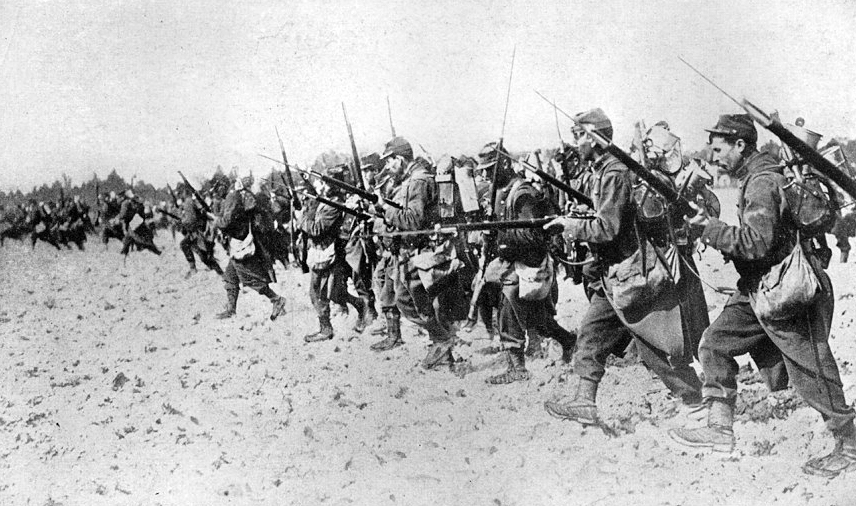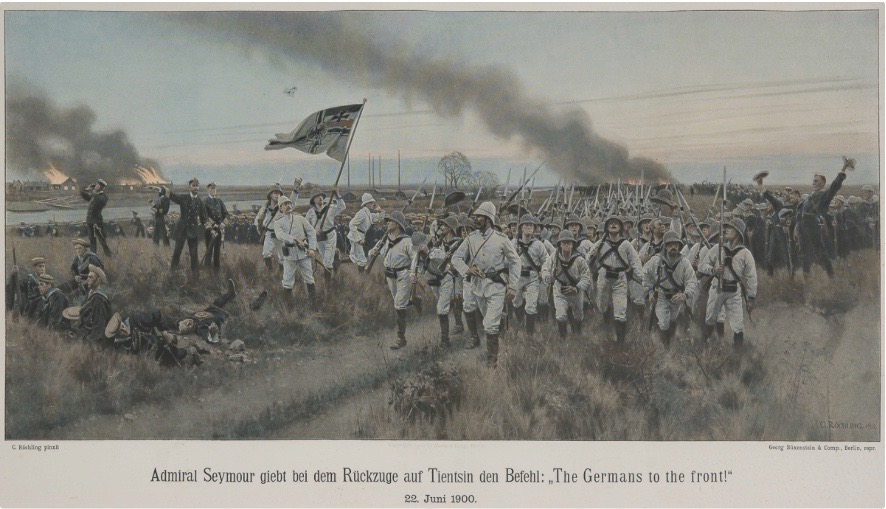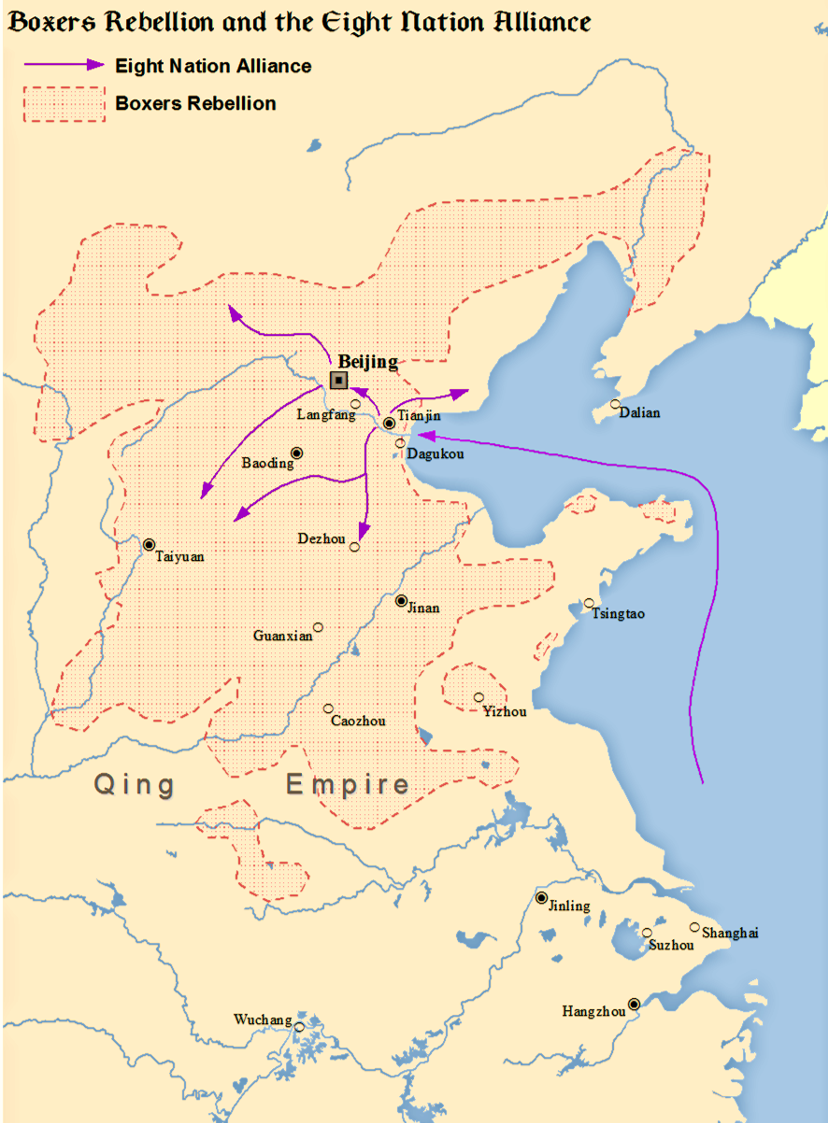|
Human Wave Attack
The human wave attack, also known as the human sea attack, is an offensive infantry tactic in which an attacker conducts an unprotected frontal assault with densely concentrated infantry formations against the enemy line, intended to overrun and overwhelm the defenders by engaging in melee combat. The name refers to the concept of a coordinated mass of soldiers falling upon an enemy force and sweeping them away with sheer weight and momentum, like an ocean wave breaking on a beach. Definition According to U.S. Army analyst Edward C. O'Dowd, the technical definition of a human wave attack tactic is a frontal assault by densely concentrated infantry formations against an enemy line, without any attempts to shield or to mask the attacker's movement. The goal of a human wave attack is to maneuver as many people as possible into close range, hoping that the shock from a large mass of attackers engaged in melee combat would force the enemy to disintegrate or fall back. The human wa ... [...More Info...] [...Related Items...] OR: [Wikipedia] [Google] [Baidu] |
French Bayonet Charge
French (french: français(e), link=no) may refer to: * Something of, from, or related to France ** French language, which originated in France, and its various dialects and accents ** French people, a nation and ethnic group identified with France ** French cuisine, cooking traditions and practices Fortnite French places Arts and media * The French (band), a British rock band * "French" (episode), a live-action episode of ''The Super Mario Bros. Super Show!'' * ''Française'' (film), 2008 * French Stewart (born 1964), American actor Other uses * French (surname), a surname (including a list of people with the name) * French (tunic), a particular type of military jacket or tunic used in the Russian Empire and Soviet Union * French's, an American brand of mustard condiment * French catheter scale, a unit of measurement of diameter * French Defence, a chess opening * French kiss, a type of kiss involving the tongue See also * France (other) * Franch, a sur ... [...More Info...] [...Related Items...] OR: [Wikipedia] [Google] [Baidu] |
Sino-Vietnamese War
The Sino-Vietnamese War (also known by #Names, other names) was a border war fought between China and Vietnam in early 1979. China launched an offensive in response to Vietnam's Cambodian–Vietnamese War, actions against the Khmer Rouge in 1978, which ended the rule of the Chinese-backed Khmer Rouge. Both China and Vietnam claimed victory in the last of the Indochina Wars. Chinese forces invaded northern Vietnam and captured several cities near the China-Vietnam border, border. On 6 March 1979, China declared that the gate to Hanoi was open and that their punitive mission had been achieved. Chinese troops then withdrew from Vietnam. As Vietnamese troops remained in Cambodia until 1989, China was unsuccessful in its goal of dissuading Vietnam from involvement in Cambodia. Following the dissolution of the Soviet Union in 1991, the Sino-Vietnamese border was finalized. Although unable to deter Vietnam from ousting Pol Pot from Cambodia, China demonstrated that its Cold War commu ... [...More Info...] [...Related Items...] OR: [Wikipedia] [Google] [Baidu] |
Spanish Civil War
The Spanish Civil War ( es, Guerra Civil Española)) or The Revolution ( es, La Revolución, link=no) among Nationalists, the Fourth Carlist War ( es, Cuarta Guerra Carlista, link=no) among Carlists, and The Rebellion ( es, La Rebelión, link=no) or The Uprising ( es, La Sublevación, link=no) among Republicans. was a civil war in Spain fought from 1936 to 1939 between the Republicans and the Nationalists. Republicans were loyal to the left-leaning Popular Front government of the Second Spanish Republic, and consisted of various socialist, communist, separatist, anarchist, and republican parties, some of which had opposed the government in the pre-war period. The opposing Nationalists were an alliance of Falangists, monarchists, conservatives, and traditionalists led by a military junta among whom General Francisco Franco quickly achieved a preponderant role. Due to the international political climate at the time, the war had many facets and was variously viewed as cla ... [...More Info...] [...Related Items...] OR: [Wikipedia] [Google] [Baidu] |
Republican Faction (Spanish Civil War)
The Republican faction ( es, Bando republicano), also known as the Loyalist faction () or the Government faction (), was the side in the Spanish Civil War of 1936 to 1939 that supported the government of the Second Spanish Republic against the Nationalist faction of the military rebellion. The name Republicans () was mainly used by its members and supporters, while its opponents used the term ''Rojos'' (Reds) to refer to this faction due to its left-leaning ideology, including far-left communist and anarchist groups, and the support it received from the Soviet Union. At the beginning of the war, the Republicans outnumbered the Nationalists by ten-to-one, but by January 1937 that advantage had dropped to four-to-one. Foreign support The Republican faction hardly received external support from the Allied powers of World War II, due to the International Non-Intervention Committee. The support of the USSR stands out, fundamentally. Together with Mexico, France and Poland at the be ... [...More Info...] [...Related Items...] OR: [Wikipedia] [Google] [Baidu] |
Siege Of Port Arthur
The siege of Port Arthur ( ja, 旅順攻囲戦, ''Ryojun Kōisen''; russian: link=no, Оборона Порт-Артура, ''Oborona Port-Artura'', August 1, 1904 – January 2, 1905) was the longest and most violent land battle of the Russo-Japanese War. Port Arthur, the deep-water port and Russian naval base at the tip of the Liaodong Peninsula in Manchuria, had been widely regarded as one of the most strongly fortified positions in the world. However, during the First Sino-Japanese War, General Nogi Maresuke had taken the city from the forces of Qing China in only a few days. The ease of his victory during the previous conflict, and overconfidence by the Japanese General Staff in its ability to overcome improved Russian fortifications, led to a much longer campaign and far greater losses than expected. The siege of Port Arthur saw the introduction of much technology used in subsequent wars of the 20th century (particularly in World War I) including massive 28 cm howit ... [...More Info...] [...Related Items...] OR: [Wikipedia] [Google] [Baidu] |
Dong Fuxiang
Dong Fuxiang (1839–1908), courtesy name Xingwu (), was a Chinese general who lived in the late Qing dynasty. He was born in the Western Chinese province of Gansu. He commanded an army of Hui soldiers, which included the later Ma clique generals Ma Anliang and Ma Fuxiang. According to the Western calendar, his birth date is in 1839. Religion Dong Fuxiang was a non-Muslim Han Chinese general who commanded Muslim Hui soldiers. Conflicting accounts were given about his religion and ethnicity. Contemporaneous Western sources claim he was Muslim, which was a mistake, but modern Western sources either say he was not Muslim, or did not mention his religion at all when talking about him, and some mistakenly still say he is Muslim. The only thing that was clear about him was that he was familiar with the Muslim militia of Gansu, and commanded Muslim troops in battle. The British consular officer Erich Teichman traveling in Gansu was repeatedly told that Dong Fuxiang was Han Chinese and ... [...More Info...] [...Related Items...] OR: [Wikipedia] [Google] [Baidu] |
Battle Of Langfang
The Battle of Langfang was a battle in the Seymour Expedition during the Boxer Rebellion, in June 1900, involving Chinese imperial troops, the Chinese Muslim Kansu Braves and Boxers ambushing and defeating the Eight-Nation Alliance expeditionary army on its way to Beijing, pushing the Alliance forces to retreat back to Tientsin (Tianjin). The Alliance force at Langfang consisted of Germans. Preceding clashes The Chinese Imperial Tenacious Army under General Nie Shicheng was waging a brutal campaign to suppress the Boxers under orders from Commander in Chief Ronglu. At the same time General Nie was fighting the Boxers (Militia United in Righteousness, ''Yihetuan''), the foreign Eight-Nation Alliance launched an invasion of China to reach the Legations at Beijing. The Imperial Court then decided to change its tack and halt the suppression campaign against the Boxers and fight the foreigners instead. There was too much bad blood between General Nie and the Boxers for them to cooperate ... [...More Info...] [...Related Items...] OR: [Wikipedia] [Google] [Baidu] |
Seymour Expedition
The Seymour Expedition was an attempt by a multi-national military force to march to Beijing and relieve the Siege of the Legations and foreign nationals from attacks by government troops and Boxers in 1900. The Chinese army and Boxer fighters defeated the Seymour armies and forced them to return to Tianjin (Tientsin). It was followed later in the summer by the successful Gaselee Expedition. Historical background Boxer bands advanced on Beijing in May and June 1900. The Qing court was ambivalent about the Boxers, fearing that they might become anti-Qing. The Boxers became a serious threat to Western and Japanese citizens, murdering missionaries and Chinese Christians living northern China. The diplomatic legations in Beijing requested that guards be sent to protect them. As such, more than 400 marines and naval troops from eight countries arrived in Beijing on 31 May. However, as the Boxers began posing a more significant threat, it became apparent that additional troops we ... [...More Info...] [...Related Items...] OR: [Wikipedia] [Google] [Baidu] |
Eight-Nation Alliance
The Eight-Nation Alliance was a multinational military coalition that invaded northern China in 1900 with the stated aim of relieving the foreign legations in Beijing, then besieged by the popular Boxer militia, who were determined to remove foreign imperialism in China. The Allied forces consisted of about 45,000 troops from what have, in popular tradition, been called eight 'nations' but included several empires, so thus actually far more than 8 nations in our contemporary 21st century terms, comprising: the German Empire, the Empire of Japan, the Russian Empire, the British Empire, particularly including forces from its full and sub-continent domains of Australia which was not a discrete official alliance signatory and the Empire of India, France which continued with overseas possessions, the United States which as democracy has historically demurred its global reach as 'empire', Italy, a kingdom in this peirod, and the Empire of Austria-Hungary. Neither the Chinese nor the qu ... [...More Info...] [...Related Items...] OR: [Wikipedia] [Google] [Baidu] |
China
China, officially the People's Republic of China (PRC), is a country in East Asia. It is the world's most populous country, with a population exceeding 1.4 billion, slightly ahead of India. China spans the equivalent of five time zones and borders fourteen countries by land, the most of any country in the world, tied with Russia. Covering an area of approximately , it is the world's third largest country by total land area. The country consists of 22 provinces, five autonomous regions, four municipalities, and two Special Administrative Regions (Hong Kong and Macau). The national capital is Beijing, and the most populous city and financial center is Shanghai. Modern Chinese trace their origins to a cradle of civilization in the fertile basin of the Yellow River in the North China Plain. The semi-legendary Xia dynasty in the 21st century BCE and the well-attested Shang and Zhou dynasties developed a bureaucratic political system to serve hereditary monarchies, or dyna ... [...More Info...] [...Related Items...] OR: [Wikipedia] [Google] [Baidu] |
Boxer Rebellion
The Boxer Rebellion, also known as the Boxer Uprising, the Boxer Insurrection, or the Yihetuan Movement, was an anti-foreign, anti-colonial, and anti-Christian uprising in China between 1899 and 1901, towards the end of the Qing dynasty, by the Society of Righteous and Harmonious Fists (), known as the "Boxers" in English because many of its members had practised Chinese martial arts, which at the time were referred to as "Chinese boxing". After the Sino-Japanese War of 1895, villagers in North China feared the expansion of foreign spheres of influence and resented the extension of privileges to Christian missionaries, who used them to shield their followers. In 1898 Northern China experienced several natural disasters, including the Yellow River flooding and droughts, which Boxers blamed on foreign and Christian influence. Beginning in 1899, Boxers spread violence across Shandong and the North China Plain, destroying foreign property such as railroads and attacking or ... [...More Info...] [...Related Items...] OR: [Wikipedia] [Google] [Baidu] |
The New Yorker
''The New Yorker'' is an American weekly magazine featuring journalism, commentary, criticism, essays, fiction, satire, cartoons, and poetry. Founded as a weekly in 1925, the magazine is published 47 times annually, with five of these issues covering two-week spans. Although its reviews and events listings often focus on the Culture of New York City, cultural life of New York City, ''The New Yorker'' has a wide audience outside New York and is read internationally. It is well known for its illustrated and often topical covers, its commentaries on popular culture and eccentric American culture, its attention to modern fiction by the inclusion of Short story, short stories and literary reviews, its rigorous Fact-checking, fact checking and copy editing, its journalism on politics and social issues, and its single-panel cartoons sprinkled throughout each issue. Overview and history ''The New Yorker'' was founded by Harold Ross and his wife Jane Grant, a ''The New York Times, N ... [...More Info...] [...Related Items...] OR: [Wikipedia] [Google] [Baidu] |







